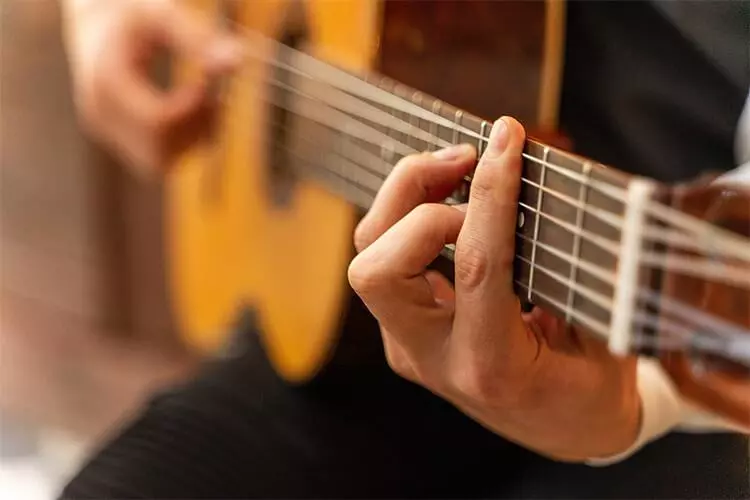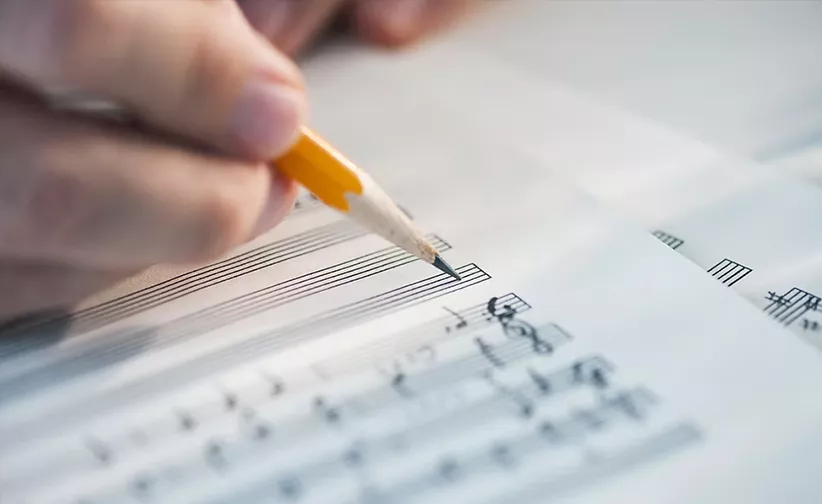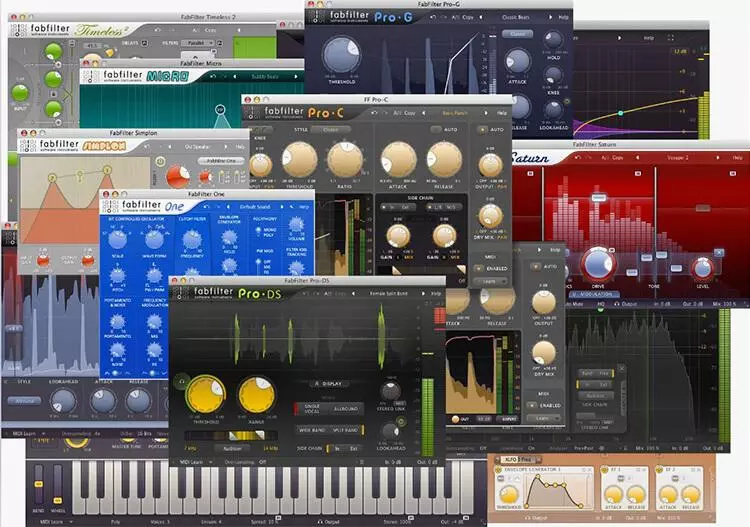Guitar chord progressions
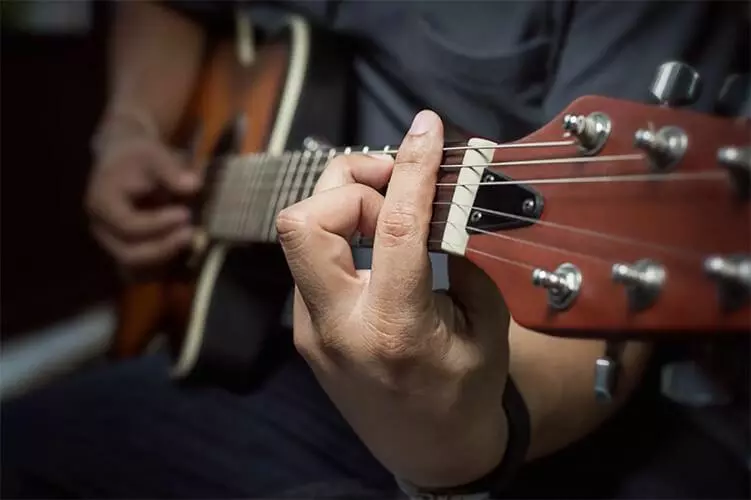
Guitarist clamps several strings and plays so that they sound at the same time – he puts a chord. If we sort through the strings in turn, we will also get a chord form, but already in the form of an arpeggio. Harmonic combinations of sounds are pleasing to the ear. When you combine them into guitar chord progressions, they take on a special magic.
The same triad in a different environment gives completely different colors, although the notes in it do not change. This is one of the manifestations of musical magic. Different songs with different guitar chord sequences demonstrate this well to us.
What does harmony consist of (notes, intervals, chords)?
We create a melody by playing notes one after another, giving them different durations and pausing between them. We create harmony by pressing several strings at the same time. All songs are built on melody, harmony and rhythm. When we play two sounds of different pitches at the same time (for example, pulling С and E), we get an interval. This is also a sound combination, but it is not yet considered a chord or a guitar chord progression. Allocate 13 intervals.
| Name | Composition | Scheme (for greater clarity on the piano) |
|---|---|---|
| Prima | One note | 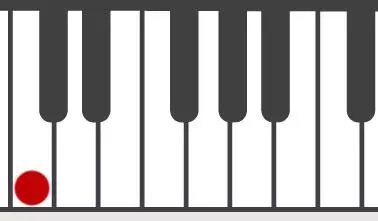 |
| Minor second | Half tone, two adjacent frets on the fretboard, or two adjacent keys, such as C and C sharp | |
| Major second | One tone, for example, C and D |  |
| Minor third | One and a half steps, C and D-sharp | 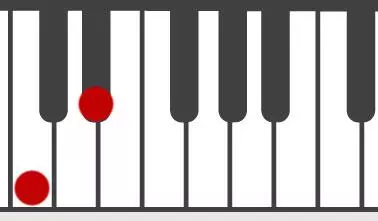 |
| Major third | Two tones, C and E | 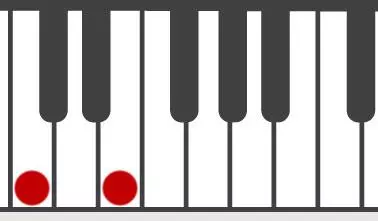 |
| Quart | Two and a half tones, C and F | 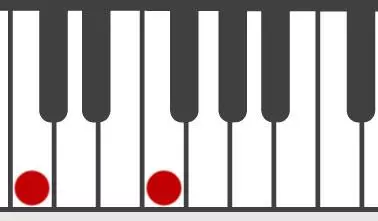 |
| Triton | Three tones, C and F sharp | 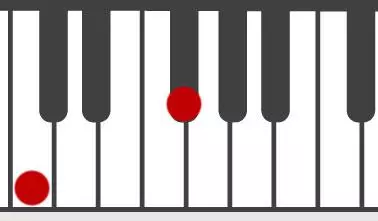 |
| Quint | Three and a half tones, C and G | 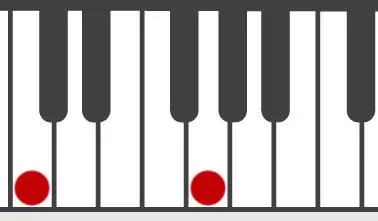 |
| Minor sixth | Four tones, C and G-sharp |  |
| Major sixth | Four and a half tones, C and A | 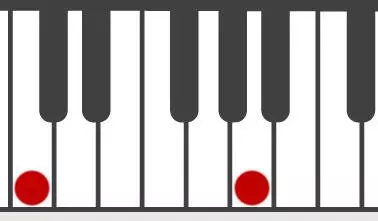 |
| Minor seventh | Five tones, C and A sharp | 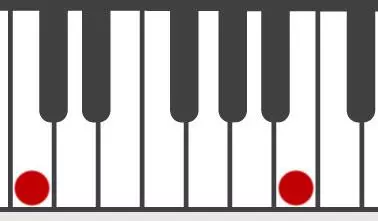 |
| Great seventh | Five and a half tones, C and B |  |
| Octave | Six tones, C and next C |  |
It is intervals that set the mood in guitar chord progressions and music in general. For example, the minority or majority of the triad depends on the location of the thirds. Seconds, tritones and sevenths are dissonant intervals. They sound harsh and unpleasant. When arranging, musicians try to carefully monitor the intersections of parts of different instruments so that a second does not accidentally form. The sound of the fifth is quite wide and pleasant. The sound of fourths and sixths can even be called majestic. Although everyone has their own associations.
Now let us move on to triads, the components of a guitar chord progression. We have only two main triads: major and minor. The major consists of a major third and a minor, and covers its fifth. Example: C – E – G. Between C and E is a large third, between E and G is a small third, between C and G is a fifth. Thus, in a chord, three intervals merge at once. If we move one note, we get a minor triad. It first comes with a minor third, and then a major one. Example: C – D-sharp – G.
A triad of two minor thirds is called diminished triad. Of the two large ones – enlarged triad. But they are not often used in guitar chord progressions, as they have a rather specific sound. There are other forms of chords – from four notes. They are called seventh chords.
We can add a major or minor third to each triad (minor, major, diminished and augmented), and we get eight seventh chords (actually seven, because an augmented triad with a major third forms an octave, and a seventh chord does not work). Can you imagine how many possibilities for building guitar chord progressions? The seventh part indicates that there is a seventh between the first and last notes in such chords. Thus, from one note we can postpone 11 chords.
| Name | Number of semitones | Letter designation | Scheme (for greater clarity on the piano) |
|---|---|---|---|
| Major triad | 4+3 | С |  |
| Minor triad | 3+4 | Cm |  |
| Reduced | 3+3 | Cdim |  |
| Magnified | 4+4 | Caug | 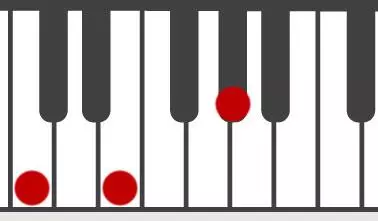 |
| Grand major seventh chord | 4+3+4 | Cmaj7 | 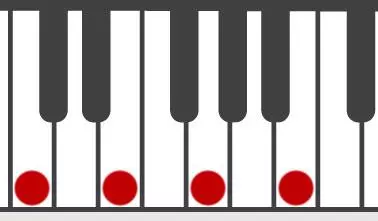 |
| Small major seventh chord | 4+3+3 | С7 | 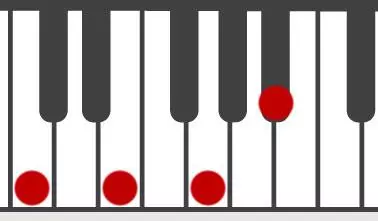 |
| Grand minor | 3+4+4 | Cm+7 | 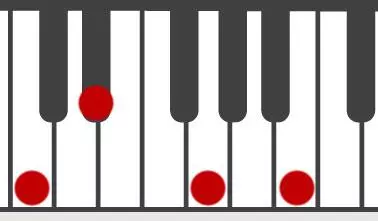 |
| Small minor | 3+4+3 | Cm 7 | 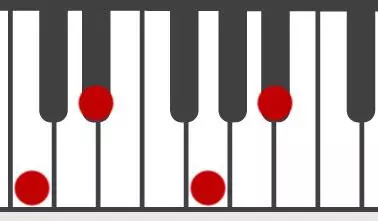 |
| Small reduced | 3+3+4 | Cm7b5 | 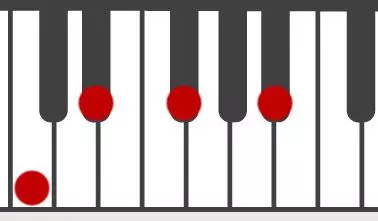 |
| Reduced | 3+3+3 | Cdim7 |  |
| Magnified | 4+4+3 | Cmaj7+5 | 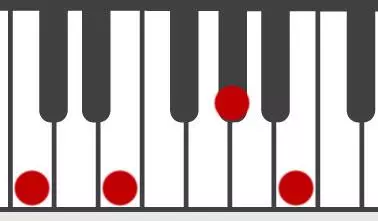 |
You can read how to use the Amped Studio Chord Generator and try to create your own melody online.
Notations, chords and functions
There are 12 notes in total: C, C-sharp, D, D-sharp, E, F, F-sharp, G, G-sharp, Aa, A-sharp, B. Then they repeat. This is the chromatic scale from C to C (includes an octave). But guitar chord progressions are rarely built on chromatics. Basically, modern music uses natural major or minor: each has 7 notes. In A minor, for example, this composition.
- La (A);
- C (B);
- Do (C);
- Re (D);
- Mi (E);
- Fa (F);
- Sal (G).

Triads are built only on these seven notes of the tonality. If another note appears, it can get into dissonance and ruin the song. But the skillful interweaving of non-tonal notes or triads can, on the contrary, enrich the work. For ease of notation, each note was assigned a letter.
A chord that is built from a particular note receives its letter. A minor triad is denoted by “m”. Magnified – “aug”. See all symbols in the table above. Thanks to the letters, guitarists can easily exchange their recordings of guitar chord progressions. For example: Em, C, G, Bb7.
At the climax, the key of the song may change. And if we played, for example, Gm-Cm-D-Gm, and then jumped up a tone, then our notation should change like this: Am-Dm-E-Am. But essentially the chain remains the same. Only the tonality, the pitch of the whole song has changed. Therefore, practicing musicians designate guitar chord sequences not with letters, but with numbers, in steps: I, II, III, IV, V, VI, VII. Others generally use Arabic numerals: 1, 2, 3, 4, 5, 6, 7. This is the so-called Nashville system. No matter what your tone is, you only need seven numbers to designate the chain.
But numerals don’t just describe a guitar chord progression or indicate a particular chord, they emphasize its function. The fact is that all triads in the key are in certain relationships, each has its own status.
- Tonic triad (built from the 1st degree: in the key of C major, this is a C major chord) – the most stable. All the rest drawn towards it, we want to end the song on the tonic;
- Dominant (on the V degree) differs in that it wants to move into the tonic most strongly;
- Subdominant (on stage IV) tends to tonic less. She runs away from her. If you move from the tonic to the dominant through the subdominant, the entire guitar chord progression will seem more solid, stable;
Speaking of notation, these three steps are also written with the letters “T”, “S” and “D”. I, IV and V are considered basic. The rest are called side, although they are also assigned functions.
- II – subdominant (this chord has two notes in common with IV);
- III – tonic and dominant (two common notes with both I and V);
- VI – tonic and subdominant (two common notes with both I and IV);
- VI – tonic and subdominant (two common notes with both I and IV).
If you play different combinations of triads and listen, you can catch how similar the gravitational force of certain functions is. But in general, all this is more of a theoretical value and is used only for the convenience of building guitar chord sequences.
How else can you write notes, intervals, triads and seventh chords? The old fashioned way: with the help of musical notation. Classical musicians do just that. But those who are just learning to play the guitar use tablature. They help to designate not only chord chains, but also the melody, and in general all the movements of the fingers along the fretboard. The top line is the thinnest string, the bottom line is the thickest. The numbers are the frets on which you need to put your fingers. Schematics are also used to learn chords. The bottom ruler is a thick string, the top one is thin. The vertical lines are the frets on the neck, and the dots are the places where you need to clamp.

Music notation, tablature and diagrams
20 examples of guitar chord progressions
Remember that each chain can be easily transferred to another key, and it will work fine there. We will denote them by numbers and letters in C major and A minor. These are parallel keys, in which all chords and notes are common, but arranged in different steps. If you turn to the piano keyboard, both C major and A minor will be located on the white keys. In general, these are the most used keys.
Major harmonic chains (on the example of C major)
1-4-5-1 (C-F-G-C). This is the most typical guitar chord progression: from tonic through subdominant to dominant and tonic.
1-6-4-5 (C-Am-F-G). This one is called the “progression of the 50s”, it was popular at that time. If you replace the fourth step with the second (do 1-6-2-5), you get a very similar movement. Such a replacement demonstrates the functionality of the steps: as we remember, the triad II is assigned a subdominant function.
1-5-6-4 (C-G-Am-F). A typical pop punk guitar chord progression, this combination was especially popular in the 90s. Here are the same triads as in the previous one, but they are in a different order.
1-5-6-3 (C-G-Am-Em). This variant is called “Pachelbel’s progression”, he used such a chain in his “Canon in D major”. It also partially repeats the previous ones, but the last step is different here, it gives an unusual paint. If you replace it with a major triad, you get an interesting transition, gravitating into F. And then you can modulate or give the guitar chord progression an original direction.
1-4-5-5 (C-F-G-G). This is also a standard combination from the tonic through the subdominant to the dominant, but the last step lasts two beats. Such a move has a touch of rock and roll or country, as it was often used in these styles.
1-4-1-5 (C-F-C-G). We see here a mutual movement: harmony walks back and forth, from the tonic to the subdominant, back to the tonic, then to the dominant, and so on ad infinitum. Country colors are also felt here, but with a more comical touch.
6-1-5-4 (Am-C-G-F). If all previous guitar chord sequences sounded lively and cheerful, then this one has a more calm, thoughtful, meditative mood. It is built in such a way that it can work for both C major and A minor. After F, you can put a dot on both C and Am.
1-5-4-6 (C-G-F-Am). It can be considered as a shifted version of the chain discussed above. This form sounds strange. But it is much better: it is easier to come up with an unusual melody for it. And it also pulls us into some kind of development.
1-2-4-5 (C-Dm-F-G). Here we have the second step. The transition from I to II, oddly enough, sounds harsh, but at the same time, it and subsequent links create an upward movement. It builds up tension, and in the end, the dominant really asks to be resolved into the tonic.
1-4-6-5 (C-F-Am-G). This beautiful guitar chord progression sounds not only energetic, but also somewhat sublime. At a certain point, we fall into a minor, but then we climb out into an even brighter than F, dominant G major chord.
| Stage | 1 | 2 | 3 | 4 | 5 | 6 | 7 |
|---|---|---|---|---|---|---|---|
| Chord | C | Dm | Em | F | G | Am | |
| Diagram | 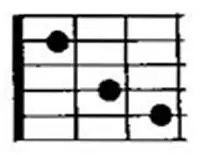 |
 |
 |
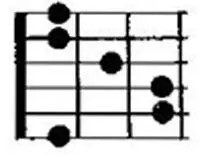 |
 |
 |
Rarely used |
Chord Diagrams in C Major
Minor harmonic chains (on the example of A minor)
1-4-5-5 (Am-Dm-E-E). In popular music, the harmonic minor E is more common than the natural Em. E has already become more familiar to our ears. The second reason why E major sits more confidently here is its G-sharp note, which is closer to A and thus gravitates more towards the tonic. And if you use the seventh chord E7, then there will be an additional gravity from D to E.
1-4-6-5 (Am-Dm-F-E). In this guitar chord progression, we arrive at the dominant through the sixth step. It performs a subdominant function, so we seem to play the subdominant twice, modifying it a little. Such a drawing is more interesting, it sounds assertive, bold, suitable for songs with a serious meaning. By the way, if you swap VI and IV places, the general mood will be preserved, but other colors will appear.
1-6-3-7 (Am-F-C-G). You can notice the absence of a dominant, but the harmonic gravity is still heard here, the guitar chord progression does not sound static. All this is due to the fact that the seventh step (G chord) performs the dominant function here. If you replace it with the dominant E (make 1-6-3-5), there will be a more concrete gravity and a more intense sound. Try it.
1-7-6-5 (Am-G-F-E). This is the downward movement of flamenco. It seems to go from tonic to dominant in tones and semitones, and then jumps through five steps. But this jump is from the dominant to the tonic, that is, with the highest gravity. Therefore, harmonic smoothness is maintained throughout the progression. An interesting, colorful and beautiful guitar chord progression, try to develop and transform it.
6-7-1-1 (F-G-Am-Am). Here, on the contrary, we observe an upward movement. And in this case, it is not very important what the tonic will be. We can equally beautifully come both in A-minor and in C-major. And if you play three repetitions of F-G-Am-Am, and do the fourth as F-G-C-C, you will have a harmonious flow from minor to parallel major. You can use this move to change the mood in a chorus or a drop.
1-7-3-5 (Am-G-C-E). The step from the seventh to the third step in this context sounds very lyrical and dramatic, and the jump to the fifth is quite abrupt. But the guitar chord progression doesn’t fall apart, but gives rich colors. By the way, this is the case when you can use both E and Em. A minor triad gives more smoothness, while a major triad gives more assertiveness.
4-5-1-6 (Dm-E-Am-F). From the very beginning, the construction gives a feeling of incompleteness, because it starts with a subdominant and a dominant. But in the middle, it acquires a solid tonic foundation. The chord of the sixth step in this case looks like a kind of bridge between the measures. In general, this is a rather lyrical and beautiful guitar chord progression, although in a certain arrangement it can become powerful and daring.
1-5-6-4 (Am-E-F-Dm). Here, without any subdominant triads, we rush to the dominant, but by the end we come to the subdominant, which even seems to sound stable. So with the help of such a move, you can try to make a modulation from A minor to D minor, if the dramaturgy of the work requires it.
6-5-1-4 (F-E-Am-Dm). A similar guitar chord progression, but even weirder and edgier. Although here we see the traditional movement D – T. But then the drawing seems to suddenly stumble and make a jump to S, and the composition loses stability. Thus, there is a feeling of constant restless wandering.
1-4-7-3 (Am-Dm-G-C). This guitar chord progression sounds very upbeat and fun. Especially compared to the previous one. A pleasant major color appears due to two major triads and the replacement of the dominant by the third step, which, as we remember, has common notes with both the tonic triad and the dominant one. In this way, rigid gravity is softened and, moreover, takes on a major form.
Rarely used
| Stage | 1 | 2 | 3 | 4 | 5 | 6 | 7 |
|---|---|---|---|---|---|---|---|
| Chord | Am | C | Dm | E | F | G | |
| Diagram |  |
Used rarly |  |
 |
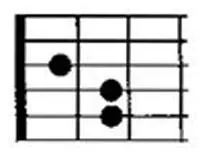 |
 |
 |
Chord Diagrams A minor
These are just a few guitar chord progressions, and that is just the basics. You can (and even need to) come up with your own chains. Change minor triads to major ones, listen to what happens, borrow chords from other keys, don’t limit yourself to a square of four triads, but develop the movement further, use seventh chords, combine several guitar chord progressions.
A few more remarks about notation. You may have noticed that the chords on the main steps (T, S, D) of a major are major, and the side chords are minor. In minor keys, the opposite is true. If the musicians know what scale they work in, the numbers 1, 2, 3, 4, 5, 6, 7 are enough for them. But in order to understand exactly which chord is major and which is minor, minors can be denoted by lowercase letters (i, ii , iii, iv, v, vi, vii), and major ones are capitalized (I, II, III, IV, V, VI, VII).
How to put chords on the guitar
When a student comes to a guitar teacher, he does not immediately give him guitar chord progressions. First, he explains how to hold the hands, hold the strings, and strike. This is a matter of habit, so at first it should be given special attention. Otherwise, you can get used to the awkward position, and you will not be able to quickly rearrange chords, play for a long time and perform complex tricks.
In general, it is recommended to find a teacher at least for the period of hand setting and technique. This can even be done online, just make sure that the teacher himself has sufficient skill. As for the study of theory, analysis of melodies, solos and guitar chord sequences, you can do all this on your own.
Conventionally, chords can be divided into open and barre. Although, as we will learn later, this is not a completely correct division and you can do without barre at all. But it’s easier to learn chords this way. There are only a few basic open chords.
| E |  |
| Em |  |
| A | 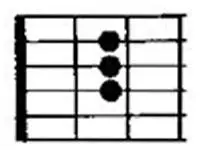 |
| Am |  |
| D | 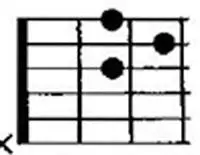 |
| Dm |  |
| G |  |
| C |  |
Open Chords
While we are not looking at seventh chords, you can learn them yourself when you master the basic forms. In general, to play guitar chord progressions in the keys of C major and A minor, you will have enough open chords. This is the most basic level.
What is barre? Without barre, it will be difficult for us to play, for example, a C minor chord. To clamp it, we need to take an open A minor and move it three frets to the right. But the unsqueezed strings in this case will be dissonant with the clamped ones. Therefore, we need to press the entire length of the index finger on the third fret completely. You use your index finger as if instead of the top plastic nut. This is called barre.

F – barre chord
In general, the chords on the entire fretboard are the same open chords, but with a barre. To play guitar chord progressions, we have several shapes: Am, A, Em, E, C. And we just change their positions by holding the bar in front of them. That is all the music. Chords like D and Dm can also be barre, but this is not very convenient, so guitarists almost never use this fingering.
We said that you can do without barre. How and why? We know that a chord has three notes, and a seventh chord has four. But when we play any guitar chord progression, it is six strings. Where are the other notes from? The rest simply duplicate the clamped ones.
For example, C-minor on a guitar has the following structure: G – C – G – C – D-sharp – G. G is clamped three times, C – two. Of course, this gives a rich sound in three octaves. But not all guitar chord progressions need this. So with your index finger, you can just mute the extra strings without pressing them down, and you’re left with just G, C, and D-sharp – all you need for a C-minor chord.
This approach cleans up the sound, gives space to other instruments, and saves effort. When economy of effort is the most important principle of guitarist technique. If the guitar has a narrow neck, you can mute the top two strings with your thumb and the bottom two with your little finger. If you play arpeggios, then these strings can not be touched at all with your right hand.
Something else will save you effort and will not require long training. This directly applies to guitar chord progressions. Learn to rearrange chords with a minimum of movement. If there are common notes in the sounding chord and the next one, leave your fingers on them, rearrange only those fingers that you need. For example, to go from Am to C, you just need to move your ring finger from the second fret and fourth string to the third fret and second string. Middle and index stay where they were. Use this principle in everything, and you will play faster, cleaner, more technical. Always look for a shortcut.
The fingerings Am and C differ by one element
9 Tips for Playing the Guitar and Building Harmony
1. Learn from the best. Watch beautiful guitar chord progressions from famous musicians. Explore popular songs that have become rock or pop classics. Take note of interesting moves and apply them in your works. No need to plagiarize, just try to capture the logic of the composition.
You can find the chords of popular songs on the Internet, but it will be more useful to independently analyze and select by ear. So you will train your harmonic perception and instill good taste in yourself.
2. Don’t skip your workouts. This applies to both the analysis of guitar chord sequences and work on technique. It needs to devote at least an hour a day. Otherwise, the skill is lost, notes are forgotten, mastery is lost. Great guitarists are great because they never part with their guitars.
But you don’t have to force yourself with music either. Take care of your pleasure. If you are analyzing a song, take the one that interests you. If you are learning a scale, try to immediately put it into practice and build a melody out of it. Practical application is much more fun than mindless cramming.
3. Always learn new chords. In the article, we took for example only guitar chord progressions with simple major and minor triads. But after all, there are still a lot of different modes, seventh chords, borrowings, parallel keys … There are so many interesting things you can still explore.
All this will replenish your musical arsenal, give new colors and inspire new songs. Learned a big major seventh chord – immediately try to place it in a guitar chord progression, come up with a melody with it, beat it in different parts of the fretboard and understand its character.
4. Listen to yourself. Record your playing and look for flaws in rhythm, picking and sound in general. Video recording will help to better track what is wrong in the setting of hands and movements. The audio recording is a good demonstration of how accurately you keep the rhythm and dynamics.
You will be surprised when you catch the difference between the recorded part and the one you hear when you play. But over time, if you constantly adjust your game, this difference will become smaller and smaller.
5. Don’t chase cool instruments. Use what is currently available. It’s better to learn guitar chord progressions and hone your skills on an old Chinese “strat” than to wait until the money for a new original “les floor” appears in the piggy bank. Even from a simple instrument, you can squeeze a decent sound.
Take the guitar to the master and he will improve it a little. If your pickups don’t give you the sound you want, experiment with pedals, amps, and plug-ins. So you will also acquire the skills of sound tuning.
6. Constantly monitor the sound and technique. It’s better to learn how to reliably mute the strings and eliminate unnecessary noise right away than to suffer every time and look for a way to play cleaner for each part and guitar chord progression. Relearning is harder than getting the right technique right from the start.
Get into the habit of playing clean right away, show patience and diligence, and then it will be much easier. Your hands will automatically move to the correct place. If this is not immediately controlled, then you will have to constantly force yourself to look for the right position.
7. Experiment and trust your ears. Typical guitar chord sequences no longer surprise anyone. Look for unusual chords. If the triad is out of the canons of all manuals and tutorials, but you hear that it works well in your context, use it. Nothing should confuse you.
Analyze the world hits and you will hear that many of them have a harmonic feature. It helps the song to get stuck in the minds of the listeners, makes the work original and evokes new emotions. And that’s exactly what we expect from good music.
8. Pay attention to the rhythm. If the guitar chord progressions are repeated in one way or another, then the rhythmic patterns give the songs their uniqueness. A series of chords that just hang on every downbeat won’t impress anyone. But, if you come up with an unusual groove for the same chain, it can sound cool.
Add syncopation, experiment with pulsations, start thinking in phrases. If there is no inspiration, just insert pauses and change the duration. And try to coordinate the rhythmic pattern of the guitar with the other parts so that the whole song sounds like a whole.
9. Listen to other instruments. Avoid dissonance with the keyboards, don’t try to take the tessitura of the bass, don’t get out of the rhythm of the drums. The work is formed by all the instruments. Learning how to interact with all the parties at once is not an easy task.
You can start with the snare and the rhythm of the guitar chord progression just to emphasize the drum groove. The bass guitar can rhythmically adapt to the kick, and melodically to the vocal line. And now everything sounds more harmonious.
Conclusion
So, we figured out how chords and guitar chord progressions are built. Now you know intervals, triads and seventh chords. We also studied the alphabetic and numeric notation systems. Now you will be able to read the chord notation and determine the composition of its functions.
If you want to learn more guitar chords, there are plenty of charts on the internet. They are all about the same, so you can use the first set that comes across. We have analyzed several guitar chord progressions so you can turn charts into music right away. Most importantly, do not delay and start applying the theory right now.


